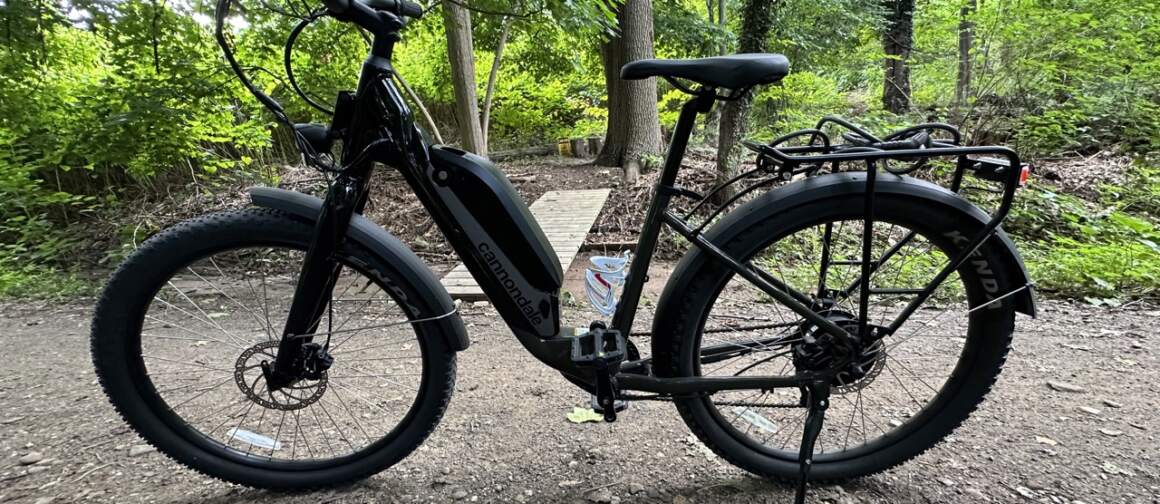
The Cannondale Adventure Neo Allroad EQ is at first glance a visually strange ebike, with its massively oversized tires, equally massive battery, fenders, lights, and a rack brazed onto the stays. It is equal parts ungainly and beautiful. Is it a commuter bike? A trail bike? A city bike?
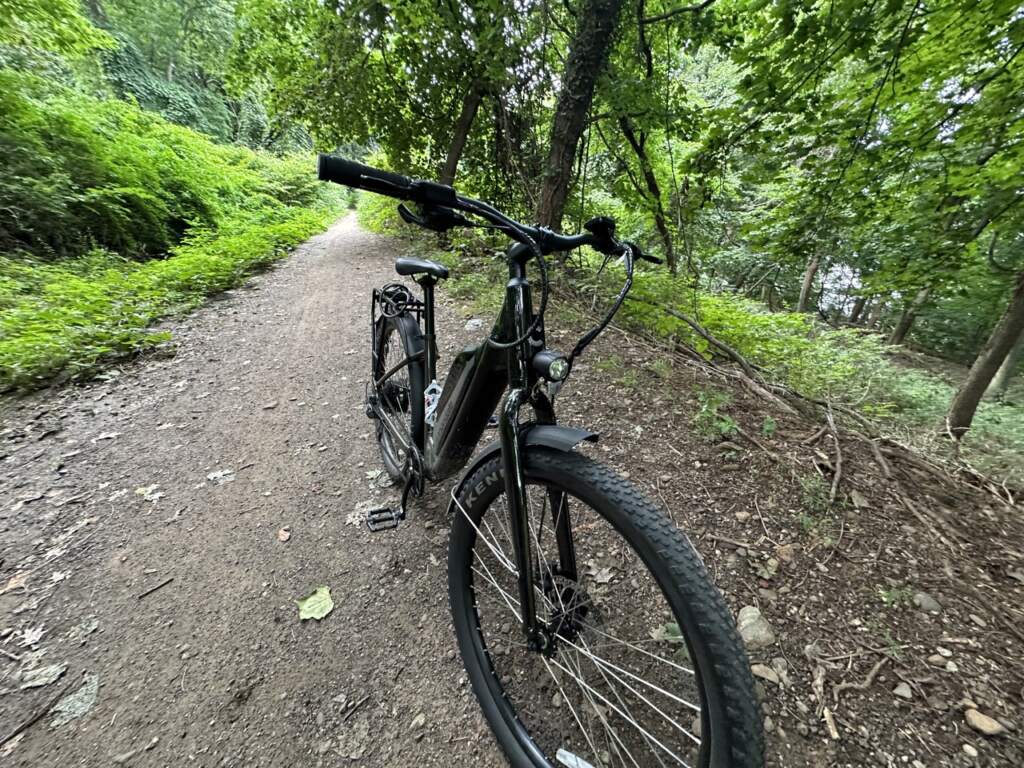
The bike is all of those things and a lot more. The Adventure Neo Allroad EQ is a shit-kicker bike, able to handle just about any trail I throw at it. And unlike many of the ebikes I have reviewed, riding is incredibly fun.
I had knee replacement surgery several months ago, and I knew ahead of time that would mean I’d be off the bike for a while, but when I got back to riding, I would need to do it with the assistance of an ebike. Cannondale had just launched the new bike (which I’ll refer to as the “Allroad EQ” or “Allroad” from now on for simplicity), and I asked them if I could review it on my way to recovery.
Ridding a sub-$2000 ebike to get back in shape for my above-$2000 Cannondale SuperSix seemed like a good plan, and Cannondale agreed, sending me the Allroad to help me recover. My healing was a bit more complicated than I had anticipated, and for the first few weeks after surgery, I couldn’t even pedal a complete stroke on a stationary bike. My knee would get to about 85º of bend and move no more.
The Allroad sat for a while, but instead of taunting me, it motivated me to do more physical therapy and to get my ass back on a bike.
It turned out to be an excellent choice in a recovery bike thanks to those big, compliant wheels and the ability of the tires to soak up road bumps. I hadn’t known that with the bones healing around, a new knee jostling up and down from potholes and ruts would be incredibly painful. I ran the pressure a bit low for my weight to help give me a bit more cush with my push.
The relaxed geometry of the bike also proved helpful, allowing me to slide my saddle back and a few extra degrees of laid-back stretch, which allowed me to turn the pedals.
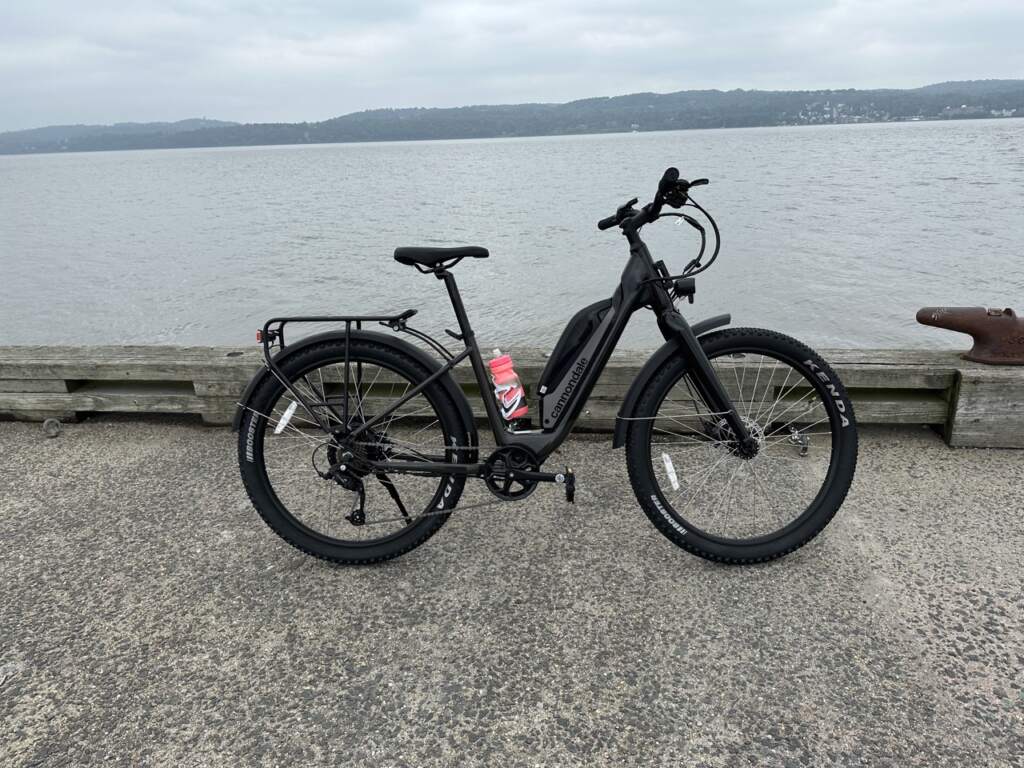
My first ride on the Allroad EQ was joyous, and I teared up. For over a month, I had struggled to pedal a stationary bike, afraid something was wrong after my surgery and I wouldn’t ride again. Riding a bike again after feeling hopeless about my prospects was liberating in the way that bike riding is as a child.
Running Up That Road
The Allroad is designed to go on trails and uneven terrain, so it doesn’t look like your average ebike. This is the kind of bike you can take on a rail to trail, but riding it, I had images of buying a cabin in the woods and using this bike to explore logging roads and double track. Ah, hell, I imagined flying down Singletrack on it a bit too.
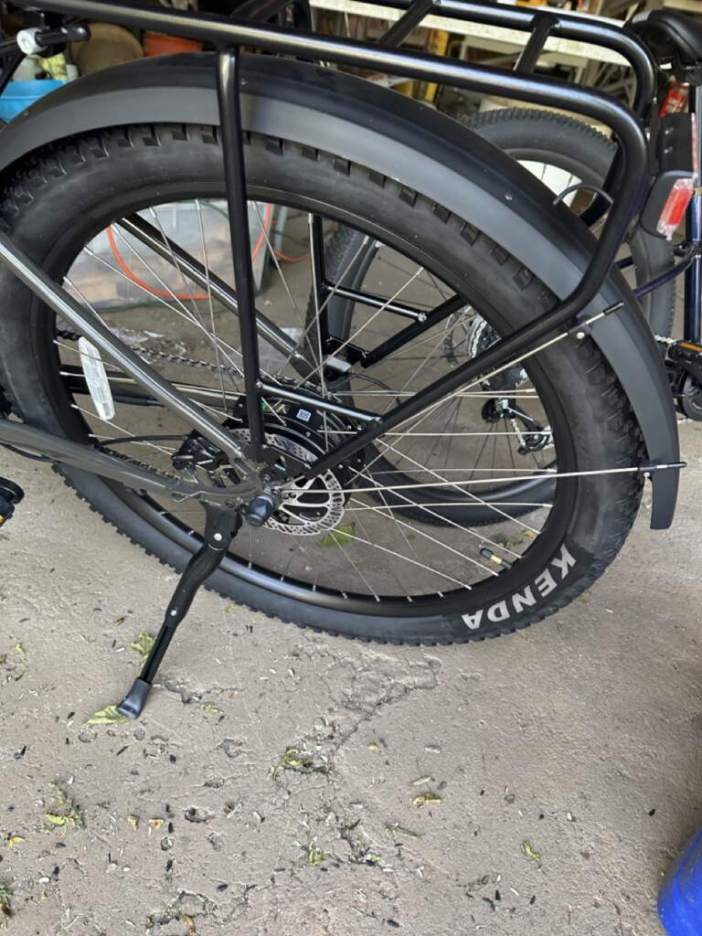
Since it’s designed for bumpy or sketchy terrain, it is a bit overpowered when riding on a flat, paved road. Not a bad overpowered, but even with the lowest level of assistance on a flat road pedaling mostly activates the motor, not providing any propulsion.

As it turns out, this is exactly what I needed. I rode first on flat roads by my house and on multiuse paved paths nearby, and I could spin my legs around while the bike did most of the work. On any other e-bike, this would be upsetting; I like a bike that helps me along but doesn’t do the work for me.

Since I was riding the bike on terrain far below its capability, this proved perfect for recovery. It also allowed me to go on errands and shopping, knowing that I could strap things to the rack on the back and bring them home. The more weight I put on the bike, the better it felt on paved roads. If I were going to own this bike (sadly, I have to send it back), I would put panniers on it and use it on trails and at my local grocery store.
Running Up That Hill
Within a week of riding the Allroad, I started to want more, well as the name implies, Adventure. Near my house is a beautiful trail in a state park alongside the Hudson River. The hardpack trail runs between a towering mountain and the shining water, and it’s one of my favorite places to ride.
While mostly flat, there are several short, steep climbs and many rolling trails. I’ve ridden cross bikes, gravel bikes, and occasionally my road bike on the first section of hardpack quite a bit. After a few miles, the trail pitches up and forks, and there are two choices. One is a 1.5-mile climb that averages 15 percent, and the other is a dirt trail through the woods to another local town.
That dirt trail would be the most sensible, with mildly rolling paths and manageable climbs.
Naturally, I picked the trail with the climb.

I put my finger on the throttle lever and started up the climb. Even though the climb averages 15%, there are two steep sections of around 20 percent. I was expecting to have to stop riding and walk up these sections.
The Allroad is equipped with a 250W hub motor and a Bafang drivetrain; on the road, it has a lot of oomph. It did admirably on the climb, although above a 10 percent grade, there is marginal assistance from the motor. It’s enough to negate the bike’s weight and give an extra push, but even with the throttle fully down, the bike still went up the hill, mainly at the speed of my pedaling.
That’s not a bad thing; I felt exhilarated at having done a lot of the pedal work up that mountain. But it also shows the limits of this bike; it wasn’t designed to be a lightweight climbing road bike, and it wasn’t intended to be a cross-country winning hardtail.
It’s a touring bike and a trail bike, and an errand bike, but it’s not going to take you to the top of Alpes d’Huez.
In truth, though, I’ve ridden many ebikes that are lighter and more road-riding oriented, and very few of them would have allowed me to finish that climb, while with the Allroad, I made it to the top, and both my knees and my lungs were intact.
If you find yourself on an extremely steep pitch and decide to hop off the bike, the drivetrain provides a walking-assist mode that will power the bike while it’s being pushed; there is no need to turn the pedals to activate the motor.
A Closer Look
The Adventure Neo Allorad EQ is powered by a 250W Bafang Go20 hub motor, with a 418Wh life that gives, they say, up to 47 miles of range. I never did a single ride of that length, but I did ride it without charging it between rides, and the battery capacity seems massive.
On a 20-mile round trip where I mostly used the bike in the lowest assistance mode possible, I had more than half the battery left when I got home. That seems right on target.
The battery is removable so that it can be charged in your house, in your office, or if you’re doing long-distance touring while you sit and have dinner somewhere.
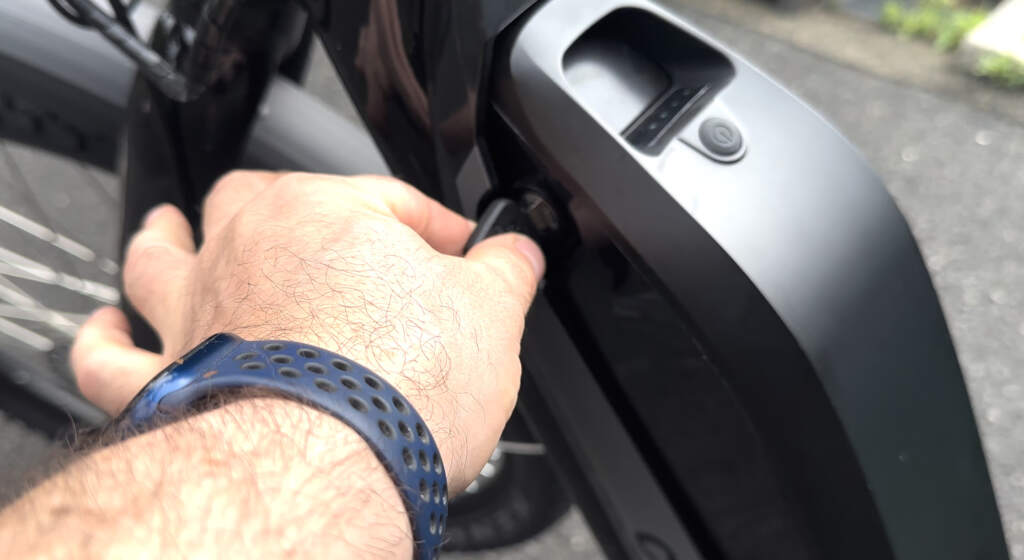
The seven-speed drivetrain is easily actuated, though I didn’t find much use. I primarily left it in the hardest gear, and I’d adjust the power drivetrain assist level or use the throttle if I needed an easier gear.
Unlike many ebikes I’ve ridden, the Adventure Neo Allroad EQ has hydraulic disc brakes, which I appreciated when I turned around on that long climb and rode the long, steep descent back to the river.
The saddle is relatively comfortable for a stock configuration, though I’d upgrade it pretty quickly if I were going to ride the bike for any length of time. Pedals are generic, as you’d expect. For long rides, I’d either go clipless or get downhill-style pedals with studs for traction. Since the drivetrain provides much of the work, clipless would be a bit overkill, but I found myself shutting off the power and riding the bike motor-free on some flat roads.
The one issue I have with the drivetrain is related to turning off the power-assist functions. It’s possible to put the bike in “0” assist (the assistance range is from 1-5) to pedal under one’s power, but when going from no-assist back up to assist, there’s a delay in the motor activating.
The result is that I’d find myself pedaling and then come to a rise in the road, and when I switched to the first level of assist, nothing would happen. Even the throttle doesn’t work when switching from “0” to “1,” and there’s no way to tell precisely when the assistance will return. I found that if I pedaled backward, the power would often return quickly, but I’m not sure if this is because I took the load off the motor or because I was killing time while pedaling in reverse.
The short stem on the bike is part of what gives it an upright geometry, and while that position was great during my recovery, I’d likely get a longer stem if I were keeping the bike. As with many short cockpit bikes with flat bars, I occasionally shook my hands to reduce fatigue, and I’d eventually like to stretch out more.
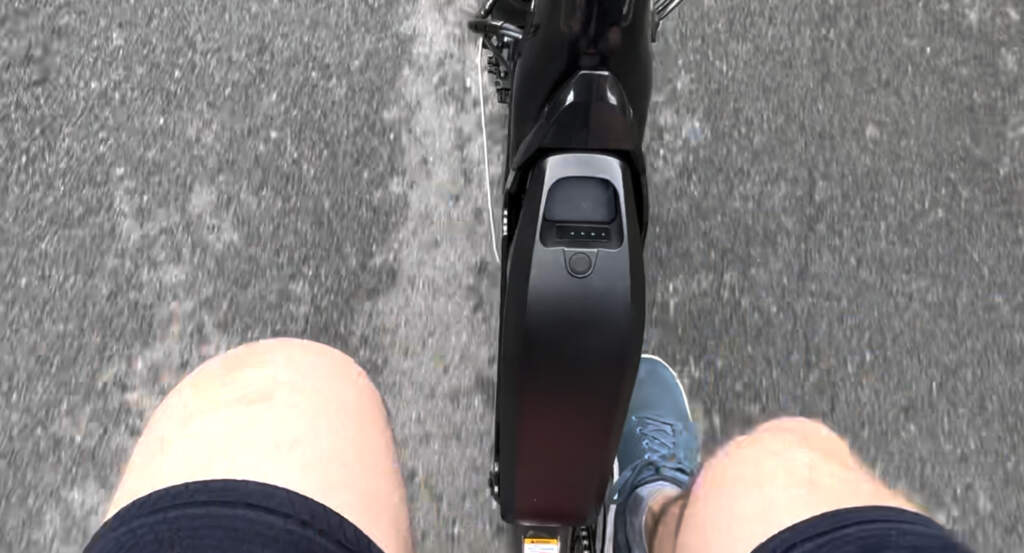
This is one of the ways that companies like Cannondale can produce these bikes without making a dozen frame sizes. With a Medium and a Large frame as the only choices, Cannondale can create these at a lower cost than multiple frames. Using standard components for the Seatpost, stem, and handlebars makes it easy to customize a bike like this to suit just about any rider.
On The Road Again
My wife used to be an avid cyclist, but a series of health issues took her off the bike after my son was born. She hasn’t ridden seriously in years, mostly because she hates the idea of riding short rides on the same local roads over and over to get in shape to ride the longer distances she enjoys on trips and vacations.
I’ve been talking about the idea of an ebike for her for years, but the ones I’ve ridden have been more commuter oriented. They’ve been stiff and heavy, designed for roads more than for trails. Those designs can make them uncomfortable and harsh to ride.
I put her on the Adventure Neo Allroad EQ, and she pedaled alongside me as I rode another stiffer bike. I’d grimace as the bike I was on hit potholes and stutter bumps, which sent jolts into my robo-knee. Meanwhile, she smiled and rode over potholes like they didn’t exist.
“Okay,” she said, “I could get back into riding on a bike like this.
On The Trail Again
A few weeks after that climbing ride, I went out with my friend Mike for our regular Sunday ride. I hadn’t been on a weekend ride with my friends this entire season. The skies were sunny and blue, the Canadian wildfire smoke had abated, and I was full of energy.
As the trail split in the forest, we turned to the right, down the five-mile bumpy dirt trail to the town up the river. I’d clear the few climbs seconds ahead of Mike and stopped a few times to eat the wild raspberries that grow along the trail.
In addition to the dangerous haze of wildfire smoke, we have had miserable weather this season. One-hundred-degree days have been followed by days of violent and damaging thunderstorms. None of my group of weekend friends has ridden a lot this season.
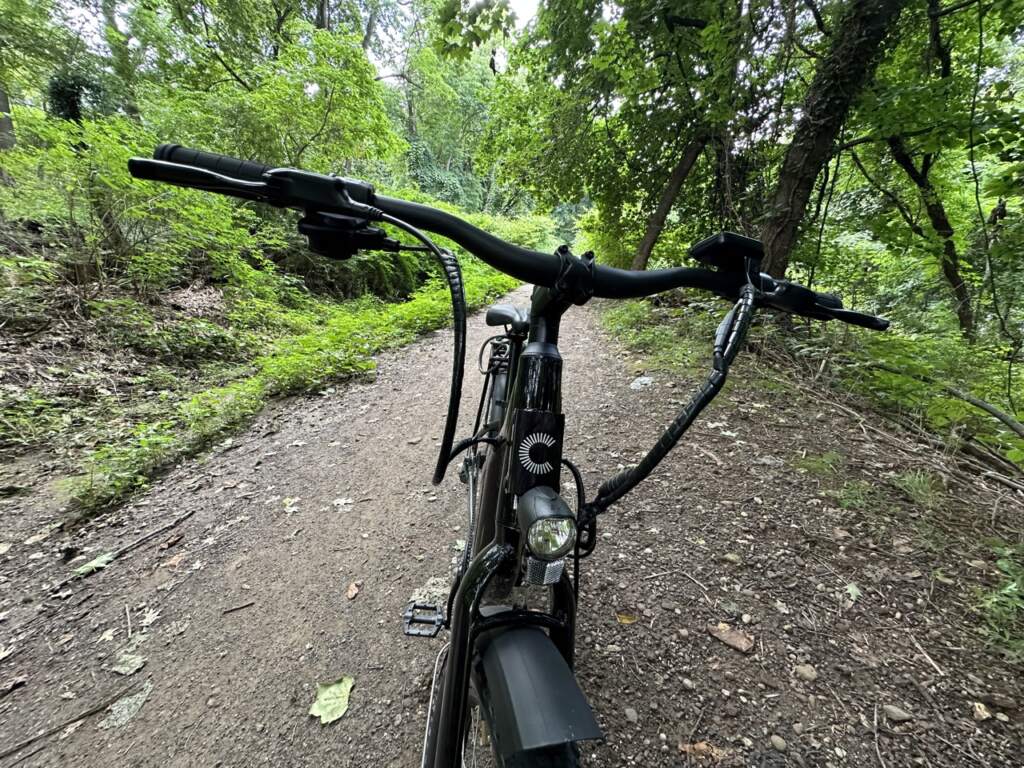
The trailhead comes out at a parking lot on a road above a town and we usually head down the road and continue our Adventure on roads that follow alongside the river.
This ride, Mike wasn’t feeling it. A few weeks out of the saddle and some knee tendon issues of his own had him feeling like turning back, which we did. On our group rides, we go where the group wants to go, and he wants to head back.
A beautiful ride home, and Mike turned off toward his house. I kept going toward the bike path on the Hudson River’s bridge. I added another 10 miles to my day, finishing at about 20 miles—the farthest I’ve ridden since my surgery.
A few weeks later, the whole gang got together for a ride; this time, I wanted to see how far the battery would take me. We did a typical route around our county, with a total distance of 30 miles and 1500 feet of climbing. Typically, we’d do 50 miles and over 2000 feet of climbing on this route, but I didn’t think my knee or the battery would last.
I spent much of the ride sipping power from the battery. My knee is improving, so I need much less assistance, running at the first power level and using the throttle less on climbing. At the halfway point, I still had three bars of power on the computer.
On the return trip, I kicked up the assistance to ensure I didn’t overtax my knee. As we approach the last climb, a gradual half mile through a park, the battery dropped from the third bar to the second at about the same rate as the first bar, but right there at the end of the ride, it dropped from two to one bar as I was doing that final climb. The bike stopped assisting me on the climb, and I could only kick in some power when the trail flattened out.
On the last mile on the return, the bike could assist with the flats, but less than on the outbound trip. This is typical of batteries; as they drop, they aren’t able to provide as much peak power. I could still ride around my block with assistance, but that’s all the bike had left.
This battery performance sounds disappointing, but a thirty-mile ride on a relatively hilly route is excellent for many e-bikes, and a flat commute would hit the 40-mile mark without a problem and likely farther on a flat rail-to-trail.
My experience with the battery’s power is just a reminder that no matter what ebike you have, there are limits to its abilities—just as is the case with human-powered bikes.
Those 30 miles with pedal assistance represent a mark in my recovery. I’m hoping to ride unassisted that length soon, and I’m hoping to get back to my regular weekly ride lengths of 50 to 70 miles next season.
But I’m also planning to have an ebike around to go on fun excursions and explore trails and terrain I’m unfamiliar with. I could not do better on those trips than with the Cannondale Adventure Neo Allroad EQ. At just a hair under $1900 it’s a great value for the avid gravel and rail-trail cyclist. It’s also incredibly durable, fun to ride, and equipped with parts that make it an excellent commuter bike that also easily can haul cargo around on the back rack.
…We're riding townies, adventure, and mountain bikes. Find recommendations on our store page. As Amazon Associates we earn from qualifying purchases.